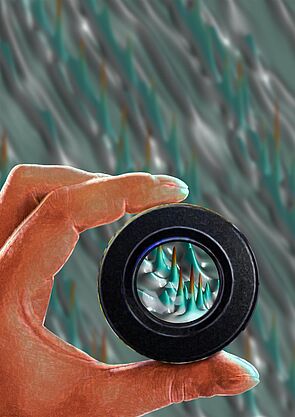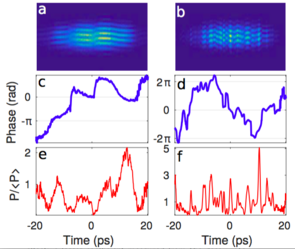
Pierre Suret
Axes de recherche
Integrable Turbulence and Soliton Gas


Ultrafast measurement of optical turbulence
Measurement of statistics
We have developed an asynchronous optical sampling setup that enables the precise measurement of the probability density function (PDF) of optical power rapidly fluctuating with time (subpicosecond time scale) [1]. We propagate partially coherent waves in single mode fibers in the anomalous (focusing) or normal (defocusing) regime of dispersion. In the focusing regime, the PDF is found to evolve from the normal law to a strong heavy-tailed distribution, thus revealing the formation of rogue waves in integrable turbulence. In the defocusing regime, the PDF becomes low tail distribution that corresponds to the emergence of dispersive shock waves in integrable turbulence [2,3].
[1] P. Walczak, S. Randoux and P. Suret, Optical rogue waves in integrable turbulence
Phys. Rev. Lett., 114, (14), 143903, (2015)[2] S. Randoux, P. Walczak, M. Onorato and P. Suret, Physica D : Nonlinear Phenomena, 333, (2016)[3] S. Randoux and P. Suret, Chapter in Rogue and Shock Waves in Nonlinear Dispersive Media, (2016)
Single-shot Measurement of phase and amplitude
In collaboration with the “group “Coherent synchrotron radiation sources” of the Phlam, we have designed and developed a time microscope ultrafast acquisition system that enables the direct single-shot recordings of sub-picosecond optical rogue waves [1]. Ultrafast structures having peak powers much larger than the average optical power are generated from the propagation of partially coherent waves in optical fibre and are recorded with 250 femtoseconds resolution. Our experiment has demonstrated the central role played by ‘breather-like’ structures such as the Peregrine soliton in the emergence of heavy-tailed statistics in integrable turbulence.
Our original setup is not a standard time lens. It uses an analogous in the temporal domain of a microscope and the final signal is record by one horizontal line of a sCMOS camera whereas standard time lens setups use photodiode. This characteristic has two important consequences: first the signal/noise ratio is extremely good (dynamical range up to 40dB) and secondly, the vertical axis of the camera may be used to record other information such as the phase (see below [2]).
In our recent Nature Photonics paper [2], we report a new heterodyne time-lens arrangement that efficiently records both the amplitude and phase of complex and random signals over large temporal windows (tens of picoseconds). Phase and time are encoded onto the two spatial dimensions of a camera. We implement this phase-sensitive time-lens system in two configurations: a time microscope and a digital temporal-holography device (SEAHORSE) that enables single-shot measurement with a temporal resolution of ~80 fs. The starting point of this work is the time microscope reported previously (El Koussaifi et al. Nat. Commu., 2016, see above) in which we use the vertical axis of the camera. The phase is encoded in a spatial arrangement by using the reference between the complex signal and a monochromatic reference. In the SEAHORSE arrangement, we remove the dispersive element applied to the signal in the standard time lens devices. As a consequence, the aberrations always induced by high order dispersion in time lenses are strongly reduced. This allows us to achieve phase and amplitude measurement with a 80 fs resolution whereas standard time lens only record the amplitude with resolution larger than 250fs. Our observations have unveiled the special evolution of the phase (and amplitude) of rogue waves in integrable turbulence (see below)
[1] P. Suret, R. El Koussai, A. Tikan, C. Evain, S. Randoux, C. Szwaj and S. Bielawski, Single-shot observation of optical rogue waves in integrable turbulence using time microscopy, Nature Communications, 7, 13136 (2016)
Highlight : CNRS News, Observer des ondes lumineuses scélérates sur des temps ultra-courts, Les Actualités scientifiques de l’Institut de Physique du CNRS, 13 avril 2017
[2] A. Tikan, S. Bielawski, C. Szwaj, S. Randoux and P. Suret, Single-shot measurement of phase and amplitude by using a heterodyne time-lens system and ultrafast digital time-holography, Nature Photonics, 12, (4), 228, (2018)
Highlights :
News &Views Nature Photonics: Cheng Lei and Keisuke Goda, The complete optical Oscilloscope, Nat. Photon., 12, pp190–191 (2018)- CNRS News: Mesurer à la fois l’intensité et la phase d’un signal optique unique avec une grande résolution et sur une large fenêtre temporelle, Actualités de l’Institut de Physique, 5 Octobre 2018,
http://www.cnrs.fr/inp/spip.php?article6179



